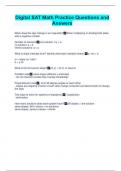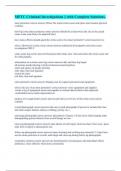A LEVEL NOTES
Marlowe Taylor
,Contents
Atomic Structure (1.1) ......................................................................................................... 3
Fundamental particles (1.1.1) ...................................................................................................................................... 3
Mass number and isotopes (1.1.2) ............................................................................................................................... 4
Electron configuration (1.1.3) ....................................................................................................................................... 6
Amount of Substance (1.2) .................................................................................................. 9
Relative atomic mass and relative molecular mass (1.2.1) ............................................................................................ 9
The mole and the Avogadro constant (1.2.2) ................................................................................................................. 9
The ideal gas equation (1.2.3) ...................................................................................................................................... 9
Empirical and molecular formula (1.2.4) .................................................................................................................... 10
Balanced equations and associated calculations (1.2.5) ........................................................................................... 10
Bonding (1.3) .................................................................................................................... 12
Ionic bonding (1.3.1) .................................................................................................................................................. 12
Nature of covalent and dative covalent bonds (1.3.2) ................................................................................................. 12
Metallic bonding (1.3.3) ............................................................................................................................................. 13
Bonding and physical properties (1.3.4) ..................................................................................................................... 13
Shapes of simple molecules and ions (1.3.5).............................................................................................................. 15
Bond polarity (1.3.6) .................................................................................................................................................. 16
Forces between molecules (1.3.7) ............................................................................................................................. 17
Energetics (1.4)................................................................................................................. 19
Enthalpy change (1.4.1) ............................................................................................................................................. 19
Calorimetry (1.4.2) .................................................................................................................................................... 19
Applications of Hess’ Law (1.4.3) ............................................................................................................................... 21
Bond enthalpies (1.4.4) .............................................................................................................................................. 21
Kinetics (1.5) .................................................................................................................... 22
Collision theory (1.5.1)............................................................................................................................................... 22
Maxwell-Boltzmann distribution (1.5.2) ...................................................................................................................... 22
Effect of temperature on reaction rate (1.5.3) ............................................................................................................. 22
Effect of concentration and pressure (1.5.4) ............................................................................................................... 23
Catalysts (1.5.5) ........................................................................................................................................................ 23
Chemical equilibria, Le Chatelier’s principle, and Kc (1.6) .................................................... 24
Chemical equilibria and Le Chatelier's principle (1.6.1) .............................................................................................. 24
Equilibrium constant, Kc for homogeneous systems (1.6.2) ........................................................................................ 24
Oxidation, reduction, and redox reactions (1.7) ................................................................... 25
Page 1 of 40
,Thermodynamics (1.8) ...................................................................................................... 26
Born-Haber cycles (1.8.1) .......................................................................................................................................... 26
Gibbs free-energy change, ΔG, and entropy change, ΔS (1.8.2) ................................................................................... 29
Rate equations (1.9) .......................................................................................................... 30
Rate equations (1.9.1)................................................................................................................................................ 30
Determination of rate equation (1.9.2) ........................................................................................................................ 31
Equilibrium constant Kp for homogenous systems (1.10)...................................................... 32
Electrode potentials and electrochemical cells (1.11) ......................................................... 33
Electrode potentials and cells (1.11.1) ....................................................................................................................... 33
Commercial applications of electrochemical cells (1.11.2) ........................................................................................ 35
Acids and Bases (1.12) ...................................................................................................... 38
Bronsted-Lowry acid-base equilibria in aqueous solutions (1.12.1)............................................................................. 38
Definition and determination of pH (1.12.2) ................................................................................................................ 38
The ionic product of water, Kw (1.12.3) ........................................................................................................................ 38
Weak acids and bases, Ka for weak acids (1.12.4) ....................................................................................................... 38
pH curves, titrations, and indicators (1.12.5) .............................................................................................................. 39
Buffer action (1.12.6) ................................................................................................................................................. 40
Page 2 of 40
, Atomic Structure (1.1)
Fundamental particles (1.1.1)
Particle Position Relative Mass Actual Mass (kg) Relative Charge Actual Charge (C)
Proton Nucleus 1 1.673x10-27 +1 +1.6x10-19
Neutron Nucleus 1 1.675x10-27 0 0
Electron Orbitals 1/1800 9.11x10-31 -1 -1.6x10-19
When neutrons were discovered, model was improved – knowledge and understanding of atomic
structure has evolved over time.
Models of the atom:
Dalton Thomson Rutherford Bohr
The first model Plum Pudding Model Nuclear Model Most recent model
- Every form of - Discovered the - Fired alpha - Found that
matter was made electron, theorised particles at a thin electrons orbited
up of small that the atom was film of gold foil the nucleus in fixed
individual particles a plum pudding energy levels – this
model – a ball of - Discovered that came from
- All matter is made positive charge most of the atom excitation energies
of atoms – with negative was empty space,
individual spheres electrons and positive - Better than
embedded in it charge is Rutherford’s model
- All atoms of a given concentrated in a as it does not
element are small, central, collapse inwards
identical in mass massive nucleus
and properties
- Electrons orbit this
- Compounds are nucleus
combinations of
different atoms - This disproved
Thomson’s work
which gave rise to
the nuclear model
Page 3 of 40












